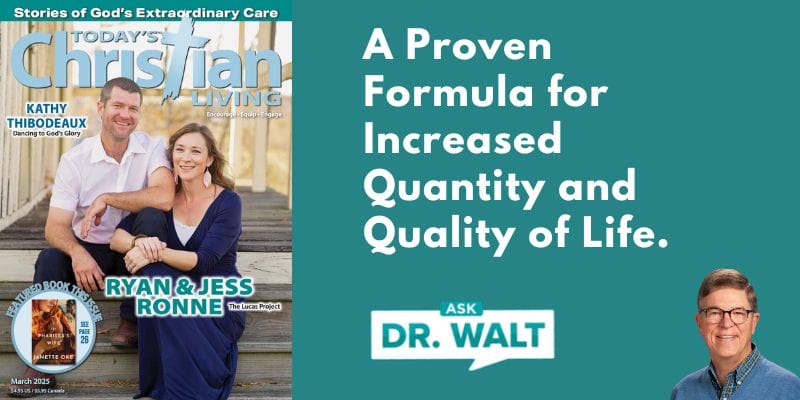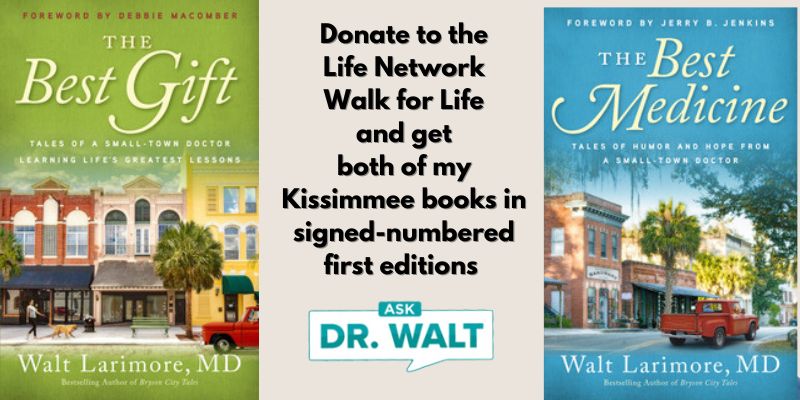
March 27, 1045 — Phil and his men luxuriated in hot water, flush toilets, soft toilet paper, and warm, clean, comfortable beds
March 27, 2025
March 30, 1945 — For Phil it was déjà vu all over again
March 30, 2025A proven formula for increased quantity and quality of life — Today’s Christian Living column for March 2025
I enjoy being penning a bi-monthly column for the readers of Today’s Christian Living magazine. In the March 2025 issue, I wrote an article you may enjoy: The Excellent Eight: A Proven Formula for Increased Quantity and Quality of Life.

March 2025 Today’s Christian Living
HERE’S THE LINK to the column which you’ll find on pages 36-37. I’ve also printed it below.
The Excellent Eight
A Proven Formula for Increased Quantity and Quality of Life
QUESTION: In the past you have written about a series of numbers I need to know about to become healthier. Can you remind me of them?
ANSWER: In my book Fit over 50: Make Simple Choices for a Healthier, Happier You, my co-author, Dr. Phil Bishop, and I have two chapters that answer your question: “You Need to Know Four Numbers” and “Five Habits to Live Ten Years Longer (or More)!” But let me both update and summarize those two chapters for you into what I now call ‘The Excellent Eight.’
Eight Excellent Factors
There are eight basic numbers that represent the healthy factors you need to know. Memorizing the numbers is even easier than learning a new phone number. The numbers are: 0, 5, 15, 30, 100, 120, 150, and 200. Here are the factors these numbers represent:
- Factor 1 = 0 = no tobacco products and no/limited alcohol
- Factor 2 = 5 = five servings of fruits and vegetables per day along with no/limited ultra-processed foods and no/limited added sugars
- Factor 3 = 15 = minutes of silence, relaxation, prayer, Bible study, meditation per day
- Factor 4 = 30 = BMI (body mass index) below 30
- Factor 5 = 100 = FBS (fasting blood sugar) below 100
- Factor 6 = 120 = systolic blood pressure (BP) below 120
- Factor 7 = 150 = minutes of exercise per week
- Factor 8 = 200 = cholesterol below 200
What happens when you practice these eight factors?
Why should you both care and want to apply all of them to your life? Simply put, if you do so, you’ll not only live better and longer, but you’ll also live with significantly fewer health issues and dramatically reduced medical costs. This may sound incredible, yet it’s true.
Researchers report that 50-year-old adults who practice just four of these “low-risk lifestyle factors” – namely numbers 1, 4, 5, and 7 above – have a life-expectancy increase of more than 12 years for men and more than 14 years for women, a whopping 48-49 percent increased lifespan! Besides living longer, you will significantly reduce your threat of premature death from cancer and cardiovascular disease. Three-fourths of premature cardiovascular deaths and half of premature cancer deaths in America are attributed to not adhering to these same four low-risk factors.
Unfortunately, national surveys show the percentage of people adhering to a low-risk lifestyle is decreasing. The CDC reports that only 23 percent of U.S. adults get enough exercise, while just one in 10 Americans eats a nutrient-rich diet (sufficient fruits and vegetables, no/limited ultra-processed foods, and no/limited added sugars).
Globally, we Americans rank 49th when it comes to life expectancy. The three highest-ranked countries are Monaco (over 89 years), followed by Japan and Singapore (over 85 years). The life expectancy in the U.S. is not higher, say researchers, because obesity and moderate alcohol use are increasing, while physical activity and consumption of a nutrient-rich diet are decreasing.
A national study reported the number of Americans with an ideal cardiovascular health score, based on seven of the factors above (1, 2, 4, 5, 6, 7, and 8) has dropped to just under six percent over the last 20 years due, primarily, to poorer scores for factors 4, 5, 6, and 8. The CDC reports 40 million Americans are living with uncontrolled high blood pressure (HBP), 39 million adults aren’t taking the recommended statin therapy to manage their abnormally high cholesterol, more than 100 million adults have poor blood sugar control (from diabetes or prediabetes), and almost 190 million adults are obese or overweight (42% obese, 31% overweight = 73% of all adults are overweight or obese).
Data from Harvard a few years back listed six of our Excellent Eight as preventable risk factors for premature death in the U.S.:
- Smoking, 467,000 deaths (one in five deaths, more than 1,300 per day)
- High blood pressure (HBP), 395,000 deaths (one in six deaths)
- Overweight/obesity, 216,000 deaths
- Sedentary behavior (inactivity or inadequate physical activity), 191,000 deaths
- High blood sugar, 190,000 deaths
- High cholesterol, 113,000 deaths
Unfortunately, many people don’t even know their risk. Thirteen percent of U.S. adults over 35 years old have not had HBP screening, 18 percent have not had cholesterol or lipid screening, and 36 percent have not had diabetes or obesity screening.
Although cigarette smoking has decreased, new forms of smoking have increased (e-cigarettes, vaping, etc.). According to the American Cancer Society (ACS), “People often think some forms are safe and don’t cause health problems. This isn’t true. There is no safe form of tobacco.” Tobacco is still the leading cause of preventable disease and death in the U.S., accounting for about one in five deaths. A 2025 study reported each cigarette smoked can reduce life expectancy by an average of 20 minutes. On average, smoking reduces life expectancy by at least 10 years.
The CDC reports that even moderate drinking increases the risk of premature death and other alcohol-related mental and physical health harms, while the ACS advises that even limited alcohol consumption has been linked to an increased risk of several types of cancer, most particularly, breast cancer. As a result, a 2025 U.S. Surgeon General’s advisory noted that alcohol is one of the three most preventable causes of cancer in the U.S., after tobacco and obesity, advising that even one drink per day can increase your risk of cancers such as breast, mouth, and throat.
Finally, daily internalized spiritual practices have been explored in numerous studies related to health. Research suggests prayer and meditation have indirect effects on physical and mental health, which potentially contributes to longer life spans. For example, purpose in life and life satisfaction, both of which are increased with prayer and Bible reading, are associated with 17% and 12% reduced mortality risk, respectively.
Daily prayer may lower blood pressure and heart rate, which can boost the immune system and increase survival rate. Religious service attendance is also associated with a 33% reduction in all-cause mortality compared with those who had never attend. Daily meditation can significantly reduce stress levels, which is linked to a decreased risk of chronic diseases, and may even slow down the aging process, which could contribute to a longer lifespan
So, what should you do to dramatically decrease your risk of premature death, increase your life expectancy, increase your quality of life, and decrease long-term medical expenses?
- For factors 1, 4, 5, 6, and 8, adults should see their family or personal physician with this list in hand.
- Factors 1 and 4 (0 = no tobacco and no/little alcohol; 30 = BMI below 30). He or she can help you stop tobacco use, review your alcohol use, and give advice for an elevated BMI.
- Factor 5 (100 = FBS below 100). Your physician can check your fasting blood sugar and/or A1C, a blood test which measures your average blood sugar over the previous three months. Blood sugar screenings every three years should start at age 45; at age 40 for those who are overweight or obese.
- Factor 6 (120 = systolic BP below 120). He or she can check your blood pressure and give you advice if it is abnormal.
- Factor 8 (200 = cholesterol below 200). Your physician can check your cholesterol or, even better, a lipid profile. A lipid profile is recommended every 4-6 years, starting at age 20, more frequently if you have any increased risk of cardiovascular disease. Starting at age 40, a calculation of a 10-year cardiovascular disease risk should be added. You can find one at tinyurl.com/5h45uz9d.
- Factor 2 (5 = five servings of fruits and vegetables per day along with no or limited ultra-processed foods and no or limited added sugars). Consider a one- or two-time family consult with a Registered Dietician Nutritional (RDN) who can help you develop a healthful nutrition plan.
- Factor 3 (15 = fifteen minutes a day of prayer, Bible study or meditation). If you need help with spiritual disciplines, see your pastor, a pastoral professional, or a Christian mentor or counselor, all of whom should be delighted to help.
- Factor 7 (150 – minutes of exercise per week). If getting 30 minutes of movement a day for 5 days a week is difficult, consider finding an exercise partner – either on your own or in a nearby gym. Most gyms have exercise experts who can help you design an exercise program that you’ll enjoy and be able to do on your own.
Other factors to consider
I have not mentioned other important factors that can improve your health, such as dealing with negative emotional, mental, or relational factors; updating recommended vaccines; reducing screen and sedentary time; improved sleep quality; increasing enjoyable social contacts; and spending more time in nature or outside and at play, recreation, and vacation. But these are all icing on the cake compared to the importance of The Excellent Eight. Blessings on the journey.
Walt Larimore, MD, has been called one of America’s best known family physicians and has been named in the “Guide to America’s Top Family Doctors,” “The Best Doctors in America,” “Who’s Who in Medicine and Healthcare,” and “Who’s Who in America.” He’s a former Vice President and Physician in Residence at Focus on the Family and the American Life League has named him a “Rock-Solid Pro-Life” awardee. He’s also an award-winning medical journalist and the best-selling author of over 40 books. He and his childhood sweetheart and wife of 50 years, Barb, have two adult children and reside in Colorado Springs. You can find Doctor Walt’s health blog at www.DrWalt.com and follow him on Facebook at “DrWalt.com”. Have questions for Dr. Walt? Email them to editor@todayschristianliving.org.
© Copyright WLL, INC. 2025. This blog provides healthcare tips and advice that you can trust about a wide variety of general health information only and is not intended to be a substitute for professional medical advice, diagnosis, or treatment from your regular physician. If you are concerned about your health, take what you learn from this blog and meet with your personal doctor to discuss your concerns.





2 Comments
Excellent advice, Dr. Walt. There is an item that I would like to add. To increase your quality of life, grab hold of an “impossible dream.” For me, my dream is that for every minute of every day, the love and the joy that Jesus purchased for me on the cross would flow through me into the lives of every person with whom I come in contact.
John,
I have such warm and wonderful memories of your mom and dad. What great role models they were for Barb and me.
Thanks for your kind words about the article. They are much appreciated.
As I write near the end of the article, “I have not mentioned other important factors that can improve your health,” of which there are many. Thanks for sharing yours.
Walt